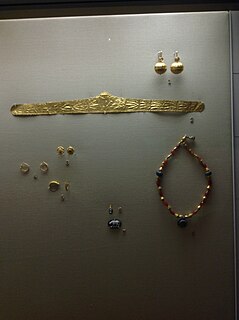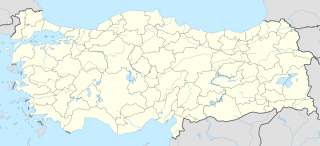Pteria was the capital of the Assyrians in northern Cappadocia. They were said by Herodotus to have been taken and ruined by Croesus in 547 BCE. It also was the place of an undecided battle between Cyrus the Great and Croesus.
Neapolis was a town in ancient Pisidia, a few miles south of Antioch. Pliny mentions it as a town of the Roman province of Galatia, which embraced a portion of Pisidia. It became a bishopric; no longer the seat of a residential bishop, it remains, under the name of Neapolis in Pisidia, a titular see of the Roman Catholic Church.
Sasima was a town of ancient Cappadocia and in the late Roman province of Cappadocia Secunda, located 24 Roman miles to the south of Nazianzus.

Miletopolis or Miletoupolis (Μιλητούπολις) was a town in the north of ancient Mysia, at the confluence of the rivers Macestus and Rhyndacus, and on the west of the lake which derives its name from the town. It was a Milesian colony. Strabo mentions that a part of the inhabitants of the town were transferred to Gargara at some indeterminant time.

Apollonia was a town of ancient Mysia, Anatolia, situated on an eminence east of Pergamum, on the way to Sardis. It seems to have been near the borders of Mysia and Lydia.
Eumeneia or Eumenia was a town of ancient Phrygia, situated on the river Glaucus, on the road from Dorylaeum to Apameia. It is said to have received its name from Attalus II, who named the town after his brother and predecessor, Eumenes II. As of the 19th century, ruins and curious sculptures still marked the place as the site of an ancient town. On some coins found there we read Εὐμενέων Ἀχαίων, which seems to allude to the destruction of Corinth, at which troops of Attalus were present. The district of the town bore the name Eumenetica Regio, mentioned by Pliny the Elder. It inhabited during Hellenistic, Roman, and Byzantine times; for a time it also bore the name Fulvia.
Maionia or Maeonia, was a city of the Hellenistic, Roman and Byzantine era located near the Hermos River, in ancient Lydia. Both Ramsay and Talbert tentatively identified the ancient polis with the modern village of Koula a village known for its carpet manufacture.
Metropolis was an ancient town in the southern part of Phrygia, belonging to the conventus of Apamea. That this town is different from the more northerly town of the name in northern Phrygia, is quite evident, even independently of the fact that Stephanus of Byzantium mentions two towns of the name of Metropolis in Phrygia, and that Hierocles. and the Notitiae speak of a town of this name in two different provinces of Phrygia. In Roman times, it was assigned to the province of Pisidia, where it became a bishopric. No longer a residential see, it remains, under the name Metropolis in Pisidia, a titular see of the Roman Catholic Church.
Heraclea or Herakleia, also transliterated as Heracleia, was a town of ancient Aeolis. It was opposite to Hecatonnesi. This town and the neighbouring Coryphantis are called villages of the Mytilenaeans. The town may also have carried the names Elateia, Idale, and Itale during Roman times.
Germa or Germe or Germae or Germai (Γέρμαι), or Hiera Germa or Hiera Germe, meaning 'holy Germa', also known as Germa in Hellesponto to distinguish it from several other towns named Germa, was a town of ancient Mysia, situated between the rivers Macestus and Rhyndacus. It appears in episcopal notices as an archbishopric. and was represented at the Council of Ephesus and Calcedon by the towns bishop. No longer the seat of a residential archbishop, it remains a titular see of the Roman Catholic Church.
Conana or Konana was an inland town of ancient Pisidia inhabited during Hellenistic, Roman, and Byzantine times. The town may also have been called Justinianopolis or Ioustinianoupolis (Ἰουστινιανούπολις). The town was a bishopric in early days of Christianity; no longer the seat of a residential bishop, it remains a titular see of the Roman Catholic Church.
Augusta was a town in the interior of ancient Cilicia, inhabited during Roman and Byzantine times. The name shows that it was either founded under the patronage of some Roman emperor, or a new Roman name was given to an old place. Ptolemy places this town in a district named Bryelice. The town also bore the name Augustopolis, and possibly Thebae.
Midaeium or Midaëum or Midaeion, or Midaium or Midaion (Μιδάιον), was a town in the northeast of ancient Phrygia. It was situated on the little river Bathys, on the road from Dorylaeum to Pessinus, and in Roman times belonged to the conventus of Synnada. In the Synecdemus it appears as Medaium or Medaion (Μεδάϊον). The town, as its name indicates, must have been built by one of the ancient kings of Phrygia, and has become celebrated in history from the fact that Sextus Pompeius, the son of Pompey the Great, was there taken prisoner by the generals of Marcus Antonius, and afterwards put to death. It has been supposed, with some probability, that the town of Mygdum, mentioned by Ammianus Marcellinus, is the same as Midaeium.
Sadagolthina was a town of ancient Cappadocia, inhabited in Byzantine times. The town is known for being the ancestral place of Ulfilas, missionary to the Goths.
Diacopa or Diakopa was a town in the west of ancient Pontus, inhabited in Hellenistic and Roman times. The town gave its name to a region of Pontus called the Diacopene.
Perta was a town of ancient Lycaonia, inhabited in Roman and Byzantine times. The town appears as Petra on the Tabula Peutingeriana.
Coropassus or Koropassos, also known as Coropissus or Koropissos (Κοροπισσός) as the name appears on its coins, was a town of ancient Lycaonia, inhabited in Roman times. Strabo says that the boundary between the Lycaonians and the Cappadocians is the tract between Coropassus in Lycaonia and Gareathyra, a small town of the Cappadocians. The distance between these two places was about 120 stadia. In the second of these two passages the name of the Cappadocian town is written Garsaura, which is the true name. The place is therefore near the western border of Cappadocia, south of the salt lake of Tatta. Adopissus in Ptolemy is probably the same place.
Homana or Homona, also known as Homonadeis, was a town of ancient Pisidia and later of Isauria and Lycaonia, inhabited in Hellenistic and Roman times. Pliny the Elder puts the town in Pisidia. It appears in the Synecdemus as part of Lycaonia under the name Umanada or Oumanada. It was the capital of the Homanades (Ὁμαναδεῖς), who, besides Homana, are said by Tacitus to have possessed 44 forts, a statement opposed to the remarks of Strabo, according to which the Homanades, the most barbarous of all Pisidian tribes, dwelt on the northern slope of the highest mountains without any towns or villages, living only in caves. In the reign of Augustus, the consul Quirinius compelled this little tribe, by famine, to surrender, and distributed 4000 of them as colonists among the neighbouring towns. It became a bishopric; no longer the seat of a residential bishop, it remains, under the name of Homona, a titular see of the Roman Catholic Church.
Cidramus or Kidramos, also known as Kidrama, was a town of ancient Phrygia and later of Caria, inhabited in Roman and Byzantine times. It became a bishopric; no longer the seat of a residential bishop, it remains a titular see of the Roman Catholic Church. The town issued coins with the legend ΚΙΔΡΑΜΗΝΩΝ.
Conium, also called Conni, Conna, Konna, Kone, Cone, Demetrioupolis and Demetriopolis, was a town of ancient Phrygia Magna. According to the Peutinger Table, where the town name appears as Conni, it was located between Eucarpia and Nacolea, 32 Roman Miles from Eucarpia and 40 from Nacolea. Pliny the Elder calls the town Conium; Ptolemy calls it Conna or Konna. Under the Byzantine empire the town was called Cone or Kone, and was a bishopric of Phrygia Salutaris, of which Synnada was the metropolis. No longer the seat of a residential bishopric, it remains, under the name Cone, a titular see of the Roman Catholic Church.


